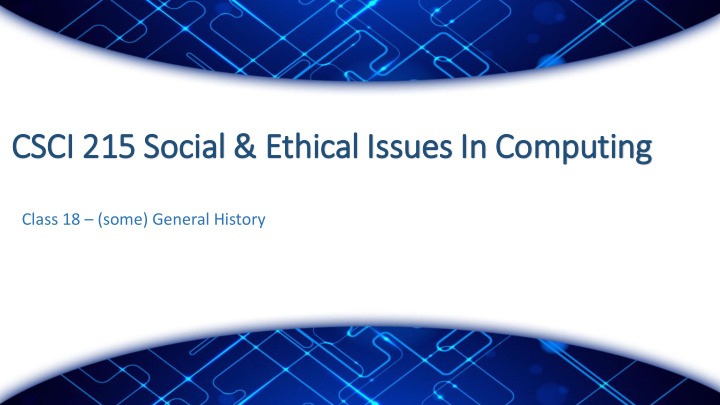



CSCI 21 215 Soc ocial & Eth thical Iss Issues In In Com omputing Class 18 – (some) General History
Not otes • Final Tomorrow
Revie iew • If I don’t hug you because I don’t want you to hug me, which ethical guideline am I following?
Que uestio ion What was the first computer?
“Computer” • “Computer” comes from “Compute”, which comes from 1630’s France • “Compute” derived from Latin “computare”, which means to count, sum up • “Computer” in relation to an electrical machine didn’t occur until 1946
~ ~ 1300 BC Aba bacus • Counting Frame / Calculating Tool
~ ~ 1300 BC Math th Tab able les
1801 Ja Jacquard loom looms • Used replaceable punch cards to weave complex patterns in textiles
1791 1791 – 1871 Cha harle les Bab abbage • Difference Engines: create tables of polynomials • Analytical Engines : steam-driven, general purpose machines
1815 1815-1852 Ada da Lovel elace • Never met her father, who was a poet. Her mother, not wanting her to end up like her father, pushed Ada towards mathematics. • She set to work translating Babbage’s analytical engine, appending her own notes, which described the promise of a general computer and even proposed it would be able to generate music. • Published description of a stepwise sequence of operations for solving certain mathematical problems • Ada is often referred to as 'the first programmer'.
1860 1860 - 1929 Herm erman Hol olle lerit ith 1890 census : Designed a punch card system to calculate the US census Took just 2.5 years (compared to previously 7) Saved the government $5 million He establishes a company that would ultimately become IBM The 60 million cards fed manually into machines like this for processing. An average operator could process about 7,000 cards a day, at least ten times faster than manual methods.
1912 1912 – 1954 Ala lan Tur urin ing
Vac acuum Tub ubes (1 (1906)
1903 1903 - 1957 Jo John von on Neu eumann • Credited with realizing computers can both execute instructions and store memory - von Neumann Architecture • Created the idea of self-replicating automata (by pencil and paper) – remember viruses? • Unofficially credited with being the creator of Merge Sort Algorithm
1946 EN ENIA IAC • First electronic general-purpose computer • Used to calculate artillery firing tables • Also, calculate the feasibility of the hydrogen bomb.
1951 1951 - UNIVAC 1 • UNIV ersal A utomatic C omputer, commercial computer • Used for the 1951 Census • CBS’s Univac famously predicted Eisenhower would win 438 votes to 93 votes for Stevenson, despite being “experts” predicting Stevenson the winner • Actual results were 442-89 (obviously in favor of Eisenhower)
Moore’s Law • 1965 co-founder of Intel Gordon Moore wrote a paper called 'Cramming more components onto integrated circuits‘ • In this paper, he observed that the number of transistors per square inch on integrated circuits had doubled every other year since the integrated circuit was invented • Original prediction thought it would last for 10 years (still holds 50 years later) • Current definition refers to doubling every 18 months (a redefinition that Moore approves of)
Moore’s Law
In In the the Beg egin inning (1 (1800s)
Out utsourcin ing (1 (1970-80s) • Outsource to India • Outsourcing shifts to China
Fla Flat wor orld ld • https://www.ted.com/talks/pankaj_ghemawat_actually_the_world_is n_t_flat?language=en
Recommend
More recommend